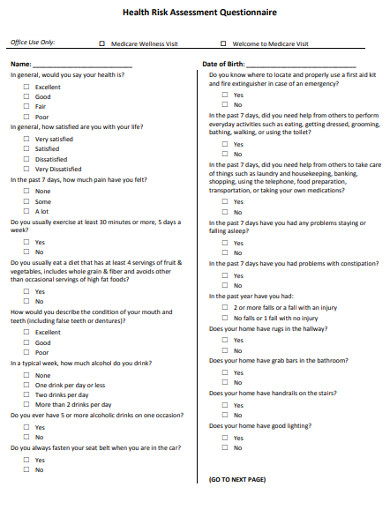Risk Evaluation Questionnaire Examples
Occupational and health hazards come hand in hand with jobs. Because some industries present higher hazard vulnerability than others, they also have higher pay rates. However, money and other incentives will not compensate for the lives lost due to incidents of negligence and subpar safety efforts in the workplace. While we cannot avoid natural disasters, we can significantly reduce the cost of the damages. The price of negligence and risk oversight is mighty. Cut back on losses with risk evaluations and effective risk management.
Risk management involves recognizing and controlling potential hazards in the workplace. After you have identified these risk factors, you look for ways to effectively address and reduce the potential harm. During risk evaluation, we review and prioritize risk management practices according to their significance and expected impact. Big and small organizations should conduct regular risk evaluations to keep the establishment in optimum operation and the workers safe from danger. How prepared is your entire institution to manage and mitigate mishaps? Identify the gaps that you need to attend to by assessing where everybody stands using risk evaluation questionnaires.
Safe Workplace is a Right
Under the common law, any employee or organization is legally responsible for its members’ welfare and safety in the workplace. This judicial precedent gave way for health and safety policies and regulations for labor and employment. Employers should strive to create a safe workplace environment for their people. By evaluating and addressing the risk factors in the workplace, work-related injuries and deaths can be avoided. In the event of disasters, employees can safely vacate the area. Health should also be given attention to. Should there be a need for medical assistance, the person will be attended by competent medical personnel.
To uphold the legal mandate, employers should perform regular risk assessments and evaluations. It is your responsibility to conduct mandatory safety training, seminar, and information dissemination for everyone in your organization. For places where occupational hazards are intertwined with the nature of the job, employers should heighten the safety measures. Because the workplace should comply with the provisions for occupational health and safety, any violation found should be addressed within a given period or risk legal consequence. The sanction can be a certain fine, jail time, or a combination of the two.
Keep Your Employees Safe
The Occupation Safety and Health Administration provides rules and regulations on what a safe workplace environment is like. However, it is up to the employers and the concerned organizations how they would put these policies to practice. Businesses and institutions can vary in their levels of risks and their safety strategy plan. The important thing is that the employees are not harmed due to negligence and substandard safety measures. Because it is up to us how we can keep our people safe, we should know the dangers that they are facing. Awareness of the odds that we are facing is the first step to beating it.
By Adjusting the Environment
Achieving a safer and healthier working environment is no easy feat. Especially for higher-risk industries, there is routine monitoring of apparatus, system, and operating procedures to keep danger at bay. We can shape the physical environment to provide cautions and emergency tools. Chemical laboratories provide a material safety data sheet for every item on the inventory that poses potential harm. Manufacturing plants and factories put up unmistakable hazard signs in areas where employees operate dangerous machinery. Buildings have fire extinguishers and smoke detectors. Tall establishments have more than one emergency exit.
By Keeping the People Informed
Aside from environmental design, employers should also keep the employees well-informed about work-related dangers and what to do during emergencies. Your people should know how to handle an unfortunate situation. Should a colleague injures himself or herself, people nearby can provide first aid in the workplace, and there is medical personnel that can attend to the case. When a fire occurs, your employees can decide whether the fire is manageable or they have to evacuate. In cases of earthquakes, they know when to hide under sturdy tables and when to exit the building. If the situation escalates, a person’s life should be the priority.
3+ Risk Evaluation Questionnaire Examples & Templates
Risk evaluation and management questionnaires are valuable documents to present to employees, stakeholders, shareholders, and health and safety accreditation personnel. These records build trust in the integrity of your organization as much as they provide reliable health and safety measures. We could not predict when a disaster or accident would strike. The uncertainty is a motivation for everyone to sufficiently prepare should an unfortunate event take place.
1.Contractor Risk Evaluation Questionnaire Example
2. Laboratory Animal Research Risk Evaluation Questionnaire Example
3. Elevate Risk Evaluation Questionnaire Example
4.Health Risk Assessment Evaluation Questionnaire Example
How To Evaluate For Risks
Risk evaluations are performed by either a capable team internal or external of the organization. The team’s qualifications include well-rounded knowledge of the risks that are present in your industry. The dedicated group will review the status of your organization in terms of risk management and practices. On risk evaluation, the team will look into the different risks that your institution faces and arranges them in order of priority. This process gives light to what poses potential danger and how you can address it.
1. Risk Identification
Risk evaluation involves the determination of the potential risks and dangers. This includes health, materials used, and the daily functions wherein there is ample room for accidents. Natural disasters, rightfully coined as acts of God because of our lack of control over them, also constitute a risk. No amount of preventive measures can stop the disaster, but with proper preparations, we can reduce the damages. Instead of guessing what the likely risks are, we can consult safety data sheets, inspection reports, records of work-related incidents, and reputable literature.
2. Order of Priority
Naturally, we can’t address the risks we identified all at once. Risk evaluations will let us identify which dangers should receive most of our attention and resources. Traditionally, we deal with the biggest threats to everyone’s safety first. They are the ones that, when ignored, can spell major disasters for the organization. We manage those first before we move on to the lesser but also potentially devastating danger. Evaluations allow us to sequence our priorities according to what is rational for our organization.
3. Control and Mitigation Strategy
After we have decided on the hierarchy of the identified risks, we can tailor an appropriate control and mitigation strategy for each risk. We can create an action plan of how we are going to deal with the risks. These control methods have to be studied and analyzed first before they are put into action. Analysis eliminates the non-scientific guessing game, which would waste our energy and resources. Successfully controlling and reducing potential harm will reward us with a safer and healthier working environment. We mustn’t take this part lightly. Otherwise, we place our employees in harm’s way.
4. Strategy Review and Report
We shouldn’t stop at implementing a strategy. We still have to study our plan yielded promising results. By following up on our actions, we can confirm if the strategy did work in reducing work-related risks. If it was effective, we could continue to implement it. If it did not do any good, we can revisit the plan and work out where we got it wrong. We should also keep records and reports of our actions. As new information comes to light, we can update our strategy. These documents are good for future reference and as evidence of our continuous risk management efforts.
Effective preventive measures and the appropriate prompt response can help the organization reduce losses and save lives. You have to know the risks your institution face and the significance of their impact. By regularly inspecting the preparedness of the employees and your risk management practices, you can avoid disastrous errors that haunt other institutions. By reducing the workplace losses, you will save your resources as well.






